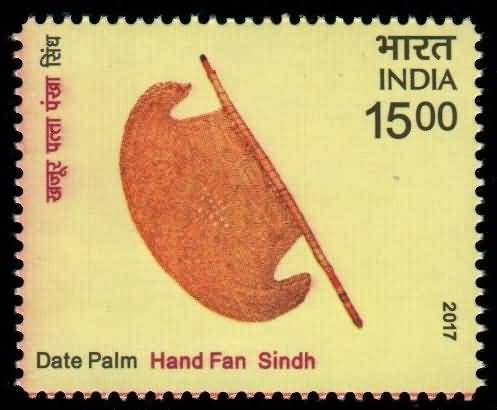Date Palm Hand Fan, Sindh

Technical Data
| Date of Issue | December 30, 2017 |
|---|---|
| Denomination | Rs. 15 |
| Quantity | 100,000 |
| Perforation | 13 |
| Printer | India Security Press, Nashik |
| Printing Process | Wet Offset |
| Watermark | No Watermark |
| Colors | Multicolor |
| Credit (Designed By) | Ms. Nenu Gupta Shri. jatin Das |
| Catalog Codes |
Michel IN 3319 Yvert et Tellier IN 3010 Stanley Gibbons IN 3445 |
| Themes | Crafts |
The Rustic Craft of Sindh
Introduction
The Date Palm Hand Fan from Sindh is a fine example of India’s and the subcontinent’s age-old craft traditions rooted in simplicity, functionality, and natural beauty. Handcrafted from soft palm leaves, this fan reflects the deep connection between people and nature, symbolizing the resourceful creativity of rural artisans. It is both a utilitarian object and a piece of living heritage, cherished for its cooling comfort and timeless craftsmanship.
Historical Background
The tradition of using hand fans in India dates back thousands of years, mentioned even in ancient epics like the Mahabharata. Fans were used in temples to fan deities, in royal courts by attendants, and in common households as everyday essentials. Over the centuries, every region of the Indian subcontinent developed its own distinct style and material tradition in fan-making, often using locally available resources.
In Sindh, where the date palm tree grows abundantly, its leaves became a natural material for crafting hand fans. The versatility, flexibility, and durability of date palm leaves made them ideal for weaving sturdy fans that provided relief from the region’s dry and hot climate.
Craftsmanship and Design
The Date Palm Hand Fan is made from young, tender palm leaves, which are harvested, dried, and softened before being handwoven into a flat or slightly curved shape. The artisans skillfully braid the leaves to form a woven pattern that ensures both airflow and strength.
These fans are often left in their natural color, retaining the earthy tones of the palm leaf, though some may feature simple dyed edges or decorative cords for aesthetic appeal. The handles are usually made from bamboo, reed, or twisted palm fibers, offering both grip and comfort.
Each fan is handcrafted with minimal tools, yet displays a beautiful uniformity and texture that speaks of the artisan’s precision and experience. The Date Palm Hand Fan embodies eco-friendly design principles, being entirely biodegradable and sustainable.
Cultural and Social Significance
In Sindh’s villages, the Date Palm Hand Fan is an essential household item. It is used to cool homes naturally during hot days and often accompanies people in their daily lives — from farmers working in fields to women sitting by the courtyard.
The fan also holds social and cultural significance, often exchanged as a token of hospitality or used during religious gatherings and community feasts. Its simplicity and durability make it a symbol of humility and comfort, deeply rooted in the traditional lifestyle of the region.
Today, these hand fans have also found new appreciation as decorative items and eco-friendly souvenirs, valued for their rustic charm and natural elegance.
Commemorative Postage Stamp
To celebrate India’s diverse craft heritage, the Department of Posts released a commemorative postage stamp series on Indian Hand Fans, featuring sixteen exquisite varieties from across the country. The Date Palm Hand Fan from Sindh was included in this collection as a tribute to the ancient craft traditions of palm-leaf weaving.
The stamp highlights the natural beauty, texture, and traditional form of the Date Palm Fan, representing not only the artistry of the Sindhi artisans but also India’s enduring connection with nature and handmade traditions.
Legacy of the Date Palm Hand Fan
The Date Palm Hand Fan of Sindh stands as a humble yet powerful symbol of craft heritage, sustainability, and rural ingenuity. Handcrafted from the gifts of nature, it embodies the timeless relationship between human hands and natural materials.
Through the commemorative stamp, this simple yet elegant craft is immortalized in philatelic history, honoring the artisans who continue to weave stories of tradition and resilience through every palm leaf.
